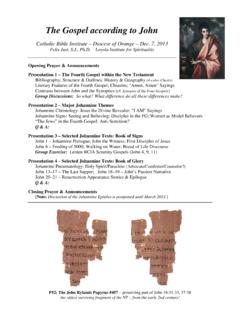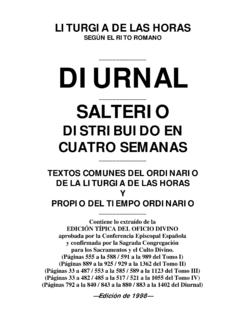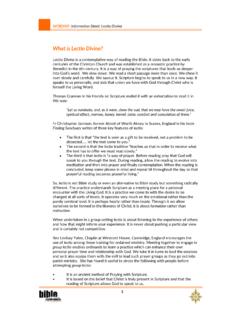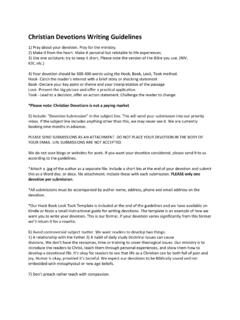Transcription of How to Read the Bible? – Catholic Approaches to Biblical ...
1 Felix Just, , How to Read the bible ? Catholic Approaches to Biblical Interpretation The Challenge of Fundamentalism Five Fundamentals of (Protestant) Christian Doctrine (from the Fundamentalist Congress of the 1890 s) 1. Inerrancy of the bible (interpreted literalistically) 2. Virgin birth & deity of Jesus 3. Substitutionary atonement (Jesus death) 4. Bodily resurrection of Jesus 5. Imminent return of Jesus Popular Appeal of Fundamentalism o Offers simplistic answers to complex questions; people crave certainty, don t like complexity or ambiguity Five Principles of Catholic Biblical Interpretation 1. Incarnational Principle of God s Self-Revelation (vs. bibliolatry, over-emphasis on bible as text) o Multiple Stages of Revelation: essentially God s Self-Revelation in and to the world Also multiple stages of Tradition: the transmission or handing down of revelation o The Word of God is not just a book, but primarily JESUS, the Pinnacle of God s Self-Revelation God sent his only begotten (John 3:16), not.
2 His only begotten book! o Incarnation: The Word became (John 1:14) Jesus is both Son of God and Son of Mary Word of God (God speaks, things happen); Word made Flesh (God speaks in limited human languages) 2. Both/And Approach to Catholic /Christian Theology ( vs. one-sided over-emphases of any type) o The bible is both the Word of God (divine inspiration) and written by human authors (language limitations) o The bible contains both Old and New Testaments; we both study it academically and read it prayerfully o Catholics interpret the bible both literally and spiritually (christologically, morally, anagogically) o Caution: We read the bible literally (as literature ), but not literalistically (as if it were mere facts ) 3. Ecclesial Guidance for Proper Understanding (vs.)
3 Individualistic misinterpretations) o Jesus, Spirit, Disciples, Church: all came before the bible was completed and compiled! The Church (guided by the Holy Spirit) created the bible , not vice-versa! o The community helps us understand the text (Homilies, Commentaries, bible study , Scripture Sharing) One s personal/individual interpretation should not conflict with long-standing Church Tradition Our Popes and Bishops are the guarantors of this Tradition (assisted by theologians and Biblical scholars) 4. Literary Genres are Diverse/Complex (vs. modernist/historicist assumptions) o GENRE = category/type of literature (art, music, etc.) characterized by a particular form, style, or content. Some publications contain multiple genres: Ex: newspapers have news, editorials, comics, sports results, financial reports, ads, obits, etc.
4 O Similarly, the bible is not just one book, but a whole library, containing many different literary genres: Hebrew bible Genres: Myths & Legends (Gen, parts of Exod, Num, Deut) Legal Codes (Lev, parts of Exod, Numb, Deut) Genealogies (parts of Genesis, much of Numbers) Annals (Josh, Judges, 1 & 2 Samuel, 1 & 2 Kings, etc.) Prophetic Books (Isaiah, Jeremiah, Ezekiel, etc.) Psalms/Odes/Songs (Psalms); Prayers/Laments (Lam) Proverbs (Proverbs); Wisdom Literature (Job, Wisdom, etc.) Apocalypse (Daniel) New Testament Genres: Gospels (Mark, Matthew, Luke, John) Acts (Acts of the Apostles) Letters (esp. Paul s); Epistles (1 & 2 Peter) Sermon (Hebrews); Wisdom Collection (James) Church Orders (1 Timothy, Titus) Testaments (2 Timothy & 2 Peter) Apocalypse (Revelation to John) many more sub-genres, esp.
5 In the Gospels 5. Historical-Critical Exegesis is Essential (vs. fundamentalist/literalist fallacies) o Foundation of Ex-egesis = leading out (drawing the intended meaning out of the text) Contrast to eis-egesis = leading into (reading your own opinions into the text) Catholics accept many different methods of exegesis: historical, literary, sociological, canonical, etc. o Multiple levels of Content & Essential Role of Context: Literal/Historical Content (original meaning) and Spiritual/Theological Content (enduring meaning) Literary/Canonical Context (surrounding texts) and Cultural/Historical Context (surrounding world) o Consideration of Historical Development: From oral preaching/tradition to written texts/scriptures; growth in understanding/application over time Official Church Documents explaining Catholic bible Interpretation Pope Pius XII: Divino Afflante Spiritu (Encyclical, 1943) Second Vatican Council: Dei Verbum: Dogmatic Constitution on Divine Revelation (1965) Pontifical Biblical Commission: The Interpretation of the bible in the Church (1993) Catechism of the Catholic Church: Part One, Section One, Chapter Two - 51-141 (1994, 1997) Pope Benedict XVI: Verbum Domini: The Word of the Lord (Post-synodal Apostolic Exhortation, 2010) Felix Just, , How to Read the bible ?
6 Plans for Choosing Which Texts to Read Canonical Approach: Reading the whole bible from beginning to end (from the Book of Genesis to the Book of Revelation). o Reading thirty or more minutes each day, or one or more chapters each day, throughout the year. Various plans for reading the whole bible in one or more years are available in print or online. o Daily Scripture and Catechism Devotional 1-year plan, by the Coming Home Network o How to Read the bible Every Day: A Guide for Catholics 1-year, 2-year, 3-year plans; by Carmen Rojas This is probably not the best method, especially not for beginners, since the Old Testament (OT) is so long and many parts of it are quite difficult; you might give up long before you even get to the New Testament (NT). Christo-centric Approach: Reading the bible one book at a time, but focusing on Jesus and seeing the relation of all the books to Jesus.
7 O Begin with one of the Gospels, for the basic story about Jesus (start with Mark, the oldest & shortest Gospel). o Then read some NT letters, followed by another Gospel; then the Acts of the Apostles, and more NT letters; then also some OT books, to learn about the history, culture, and theology of the Jewish people. You may want to read OT or NT books around the time when they occur in the Lectionary for Mass (see below). There are many good commentaries on each book or section of the bible , to help guide your study and reflection: o Collegeville bible Commentary and New Collegeville bible Commentary series by The Liturgical Press. o Little Rock Scripture study by the Diocese of Little Rock, Arkansas, and The Liturgical Press. o Six Weeks with the bible : Catholic Perspectives by Loyola Press.
8 O Paulist bible study Program by Paulist Press. Thematic/Theological Approach: Reading portions of the bible that are related to some theological, ethical, spiritual, liturgical, or other theme. o For example, reading texts related to Jesus resurrection, or to an issue of social justice, or to Mary, etc. Various booklets and guides for finding Biblical texts related to certain themes are available in print or online. o Threshold bible study thematic studies presented in short workbooks; from Twenty-third Publications. o Scripture from Scratch short flyers appropriate as bulletin inserts; from St. Anthony Messenger Press. o Interfaces a new series of short commentaries on certain Biblical characters; from The Liturgical Press. Liturgical/Lectionary Approach: Reading the short Biblical selections that are used for daily and/or Sunday Mass, as found in the Lectionary.
9 O Several Catholic publishers put out monthly booklets with the liturgical readings, along with commentaries, prayers, and/or study aides: Give Us This Day; Living with Christ; Magnificat; The Word Among Us; etc. o Readings for Mass are available on the US Catholic Bishops website: o See also the Lectionary for Mass section of my website: Reading the Scriptures Prayerfully: A Brief Introduction to Lectio Divina: Overview: Lectio Divina is a Vital Encounter with the Lord, not just bible study o It is meant to be enlivening, existential, transformative, and uniting for individuals and communities. Lectio Divina is not just for monks and religious, but for all believers: o Individuals: use and adapt Lectio Divina flexibly to one s own needs and personal prayer style. o Groups: provide a regular pattern of scriptural prayer to build openness and trust in a community.
10 The Church in America should give high priority to prayerful reflection upon the Sacred Scripture by all the faithful. This bible reading, accompanied by prayer, is known in the tradition of the Church by the name Lectio Divina, a practice that should be encouraged among all Christians. (John Paul II, Ecclesia in America, 1999, p. 31) Lectio Divina Process: (flexibly adapt the following steps, as needed, for individuals and groups) 1. Reading (lectio) hearing God s Word in the bible as I/we read it aloud o What does the Biblical text say? 2. Meditation (meditatio) reflecting on the meaning of the text that I/we have read o What is God saying to me/us through this text? 3. Prayer (oratio) speaking with God in praise, thanksgiving, contrition, and petition o What do I/we say to God in response to this text?















